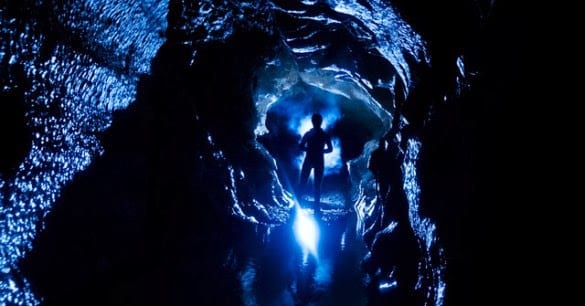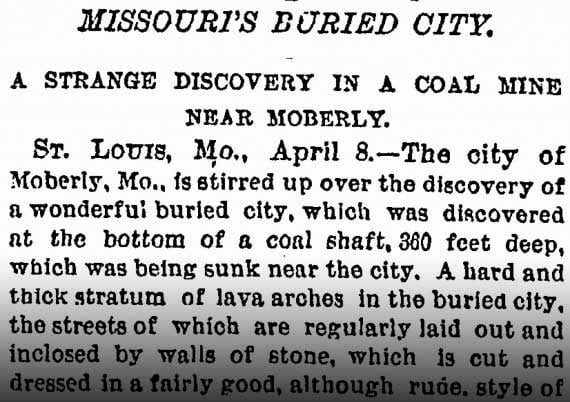Evidence Of Giants And Underground Cities In America

The most famous report – about giants and underground cities – appeared in the April 5, 1909 edition of The Arizona Gazette, entitled “Explorations in Grand Canyon.” Explorer G.E. Kinkaid discovered a huge underground “citadel” while rafting on the Colorado River.
Exploring a tunnel that stretched “nearly a mile underground,” Kinkaid found this citadel, which was filled with tablets carved with some type of hieroglyphics, and home to a stone statue he described as resembling Buddha.
Copper weapons lined the walls, but the most intriguing aspect of this ancient dwelling/worship place/tomb, were the mummies, all wrapped in a dark fabric. The mummies were supposedly more than nine-feet-tall. To feed the fire of conspiracy, and to keep anyone from finding the giants of the citadel themselves, the United States government allegedly closed that area of the canyon from public view.

But this well-known story of American giants isn’t alone
The New York Times reported a nine-foot-tall skeleton of a man discovered in a mound near Maple Creek, Wisconsin, in December 1897. The Times also carried the story “Strange Skeletons Found” near Lake Delevan, Wisconsin, in its May 4, 1912 issue. The skulls of giant skeletons excavated from a mound had “a minute resemblance to the head of the monkey.”
But an April 9, 1885 story in The New York Times entitled: “Missouri’s buried city: A strange discovery in a coalmine near Moberly,” revealed a find that predated the supposed citadel in the Grand Canyon by 24 years. Moberly, the largest city in Randolph County, Missouri, had a population of 6,108 in the 1880s.
Coal miners, sinking a shaft 360 feet deep, broke into a cavern revealing “a wonderful buried city,” the article claimed. Lava arches stretched across the roof of the cavern, looming over the streets of an ancient city “which are regularly laid out and enclosed by walls of stone, which is cut and dressed in a fairly good, although rude style of masonry.”
Workers, along with Moberly city recorder David Coates and Moberly city marshal George Keating, inspected the site and found a 30-by-100-feet hall in the cavern filled with stone benches and hand tools. “Further search disclosed statues and images made of a composition closely resembling bronze, lacking luster,” the article read.
Explorers discovered a stone fountain in a wide court, still pouring “perfectly pure water” into its basin. But it was what lay beside the fountain that interested the people exploring the site.
“Lying beside the foundation (of the fountain) were portions of the skeleton of a human being,” according to the article. “The bones of the leg measured, the femur four and one-half feet, the tibia four feet and three inches, showing that when alive the figure was three times the size of an ordinary man, and possessed of a wonderful muscular power and quickness.”
Its skull, the story reported, was shattered; bronze tools, granite hammers, metallic saws and flint knives were scattered all around. “They are not so highly polished, nor so accurately made as those now finished by our best mechanics, but they show skill and an evidence of an advanced civilization that are very wonderful,” according to the article.

Explorers spent twelve hours in the buried city and resurfaced only after the oil in their lamps burned low. “No end to the wonders of the discovery was reached,” the article stated. “A further extended search will be made in a day or two.”
No record of the extended search could be found
Dr. Tom Spencer, a professor in the department of History, Humanities, Philosophy and Political Science at Northwest Missouri State University, said that’s because after printing the story, the newspapers tried to forget it. “A lot of the time I think these stories were written based entirely off hearsay and little or no direct on-site reporting,” he said. “As the story grew, the details got more and more outrageous.”
He equates it to a childhood game where children sit in a circle and one child whispers a story into another’s ear and by the time the story completes the circle, it was completely different. “If you recall, sometimes the ‘finished story’ bore little resemblance to the original story,” he said. “My guess is one element of this story is factual – like the strange shaft formation or a long femur was found – and it became more and more embellished as it went around the journalistic circle at the time.”
So what happened to the fabulous buried city under Moberly, Mo.? “There were stories like this periodically at the time and they usually disappear quietly because someone goes to investigate and there’s nothing to it,” Spencer said. “In order to avoid the embarrassment the newspapers just don’t say anything else about it.”
However, Moberly resident John W. wants to find out for certain. “Myself and several friends have researched the article archived at The New York Times,” John said. “The article discusses coal miners finding a Crystal City with several advanced features as well as the bones of what can only be called a giant.”
John and his group plan to investigate the claim of an underground city. “We have found the mine. Our hopes are to take a field trip and find the underground city if we can access the mine,” he said. “We have driven by and the site exists. You can still see remnants of the old access road through the field. It would appear this mine has not been in use since the time period of the news article.”
Moberly calls itself “The Magic City.” Hopefully John and his crew can discover just how magic it is.
